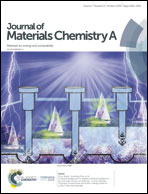Nitrogen-doped graphene quantum dots for 80% photoluminescence quantum yield for inorganic γ-CsPbI3 perovskite solar cells with efficiency beyond 16%†
Abstract
The insufficient utilization of sunlight has been a big obstacle preventing inorganic perovskite solar cells (PSCs) from achieving high power conversion efficiency (PCE). Herein, nitrogen-doped graphene quantum dots (N-GQDs) are developed to achieve a photoluminescence quantum yield (PLQY) as high as 80% to effectively convert harmful UV light into useful visible photons for improved solar cell efficiency. It is found that the N-GQD material is very stable against humidity and under high temperature stress. When it is deposited on the top of the γ-CsPbI3 PSCs, it serves as an energy-down-shift (EDS) layer to harvest light in the short wavelength range <350 nm that is normally detrimental to the perovskite. Compared with the reference cell without the N-GQDs, the optimized PSC exhibits an increased short circuit current density (JSC) of 19.15 mA cm−2 from 18.67 mA cm−2 and a PCE of 16.02% from 15.53%. Further examination of the EQE, PL and UV-vis absorption spectra confirms that the improvement in the device performance does indeed result from the N-GQDs. The present strategy paves the way for rational design to improve the performance of other novel photovoltaic devices.



 Please wait while we load your content...
Please wait while we load your content...